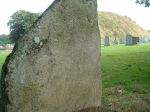The bard was asked who of the kings of Prydein
is most generous of all
‘And I declared boldly
That it was Owain’
The Gorhoffedd, 12thC heroic poem
The subject of royal lineage brings out the romantic in the scholar and the scholar in the romantic.
Lordship and kingship in a Pictish context has been given both treatments over centuries of scholarship, each with its version of history. Lately tolerance between disciplines allows students of literature, language and art history to communicate with archaeologists and pre-historians in a renewed attempt to investigate the rôle of royal centres in the Pictish kingdom.
To describe them as a lost society is to ignore the evidence.
Derilea tries here to demonstrate that the ethos of those early-Historic royal centres, far from being lost, has become incorporated within our culture and has meaning for us today.
As much as it is assisted by modern techniques, our perspective can be clouded by modern thinking.
Fealty, faith, heroism and violence are not fashionable concepts.
Yet these were an integral part of a power centre, as important as glitter of armies or riches in landholdings. Early Celtic neighbours held mutual respect for oral recitation of lineage, bravery, protection of one’s people and, in particular, generosity and hospitality.
Anyone reading the 6thC Welsh heroic poem of Aneurin, the Gododdin, which glorifies the last battle of high king and nobles of the huge fortress on Traprain, outside modern Edinburgh, cannot but marvel at the imagery of that aristocracy whose lineage hailed from 5thC Christian Votadini of treasure-hoard fame. The Welsh name Gododdin is linguistic translation for Roman Votadini.
It is difficult from our modern perspective to gain an understanding of hierarchy in the Pictish kingdoms North of the Mounth – that long barrier of mountain chain which shuts off Aberdeenshire – Pictish Cé – from all Pictish landholdings to the south, including its immediate neighbour, Kincardineshire (the Mearns) – or Picitish Cirig. Cirig and its ancient capital, coastal St Cyrus, both take their names from one of the last High Kings of both Picts and Scots Giric/Grig who was deposed in AD889. The family name Greig (including the musician) is a direct descendant of this great name.
Aberdeenshire remained elusive because historical documentation was hindered by its remoteness from both geographical and clerical centres. Physical and literary evidence is still slight; but recent scholarship accepts a correlation between Irish sources such as the Annals of Ulster (AU), Annals of Tighernach and fragments carefully compiled by Aberdeenshire historian Skene (1867), as more accurate than previously supposed, although his sources have an understandably Irish slant.
In the time of church historian Bede, (AD673-735), the Pictish nation was geographically divided by the Mounth into those southern Picts living on ‘this side of the steep and desolate mountains which separate them from the provinces of the northern Picts’ (HE Ecclesiastical History III, 4).
While early land divisions may never become crystal clear, it is known that later 9thC Pictish rule was considerably sophisticated and a distinct advance on the system of leadership of those early ‘confederations’ mentioned by Roman historians and the mythology of the Pictish creation legend (‘Irish and Pictish Additions to the “Historia Britonum”’, Skene, 1867).
Later Pictish kingship (AD500-800) invariably held power greater than that of the Scots.
Early 7th century kings of Fortriu (Forteviot) controlled the huge nation from a warlord centre near the river Earn. They had nobles spread across the nation commanding allegiance, agriculture and armies with impressive force. They also had access to skilled labour – artists, masons, carpenters, architects and military engineers.
In military terms they were no different from their Dalriatan neighbours across Druimalban, the spine of Britain as described by Adomnan, Abbot of Iona beforehe died in 703 (Vita Columbae II 46), except in ‘the exploitation of fertile land’.
No Scots king, however, ever commandeered the Columban Church in quite the same way as Nechtan, son of Derilei (706-729), controlled the Church in Pictland.
After gleaning all he needed from Anglian Jarrow on ecclesiastic propriety, ritual and usage, and borrowing skilled architects to help him build stone churches (HE V, 21), Nechtan expelled the resident familia of Iona from Court in 717. Royal control persisted for the next 170 years until the time of northern king Giric son of Donald son of Alpin (878-889) who, according to Chronikil of Kings,
‘first gave freedom to the Scots Church which was under servitude until that time after the custom and manner of the Picts’.
From mid-6thC until final assimilation by Scots, circa 843, Pictish aristocrats administered land tenure, exacting tithes and allegiance through kinship in exchange for protection, while fostering a thriving industry in decorative and domestic materials from the centre of an all-powerful local lord (or laird).
This laird in turn was subservient to the next in rank, sub-king or High King, whose central fortress would have been impressively rich in trappings of authority, and controlling vast acres of fertile agricultural ground. He too would have highly-skilled masons, metalworkers and woodcarvers at his disposal.
One of the early High kings, Bridei son of Maelchon (died 585), ‘powerful king of the Picts north of the Mounth’ lived in such a fortress, Brudei munitio near Inverness, as described by Adomnan (V.C II 35). Its obvious wealth, its size, impenetrable position, its great wooden doors barred against Columba when visiting on his first mission, all impressed the simple monk; Adomnan describes Bridei’s other powerful asset: his personal Druid, Broichan, wise-man-in
chief, consulted on augury, keeper of knowledge and laws, magician-in-residence who could ‘raise and still storms’ (V.C II 34).
Not only was Bridei’s stronghold large enough for royal family, retinue, advisors and slaves, but it housed hostages taken as a means of insuring the loyalty of an Orcadian sub-king
(V.C II 42).
In later times, when the Scots became powerful enemies, such northern fortresses, like Burghead (Moray), Dundarg (Aberdeenshire) and Dunnottar (Kincardineshire), each sited within reach of a fertile plain, were prime targets for siege-and-burn raids because of wealth, real or imagined, which could be carried off as booty. As neither side paid its army, the promise of treasure hoards in exchange for military allegiance was an important factor in maintaining a functioning force.
Warlord centres had to have quick access to surplus food supplies in order to feed workers temporarily removed from agricultural production in peacetime or soldiers during siege; this implies rich landholdings immediately adjacent, land in a wider radius, or, in time-honoured fashion, plundering one’s neighbours.
Terraces on the slopes of Dundurn two miles inland from coastal Sandend, Banffshire, indicate immediate access to a food supply, regulated planting and harvest, immediately outside the walls.

Supremely fortified Pictish warlord centre, Dunnottar was protected on three sides by sheer cliffs rising out of the North Sea
Records indicate coastal Dunnottar, on the Mounth’s eastern extremity, was besieged more than once (AU, 681, 694?). Its fortified position, set on towering cliffs, bounded on three sides by the North Sea and defended on the remaining narrow strip to mainland fields by bank and ditch enclosures, is perhaps the most dramatic of northern warlord centres. It may have been a much-prized potential conquest for Bridei son of Bile, southern Pictish ‘King of Fortrenn’ (genitive of Fortriu) in his siege of Fothair in 681. Under him great armies fought the battle of Nechtansmere near Dunnichen in 685, resulting in Pictish independence from Northumbria. Northern warrior aristocrats may have had just as powerful armies at their disposal marshalled from equally impressive royal seats. Dubhtalorc, 8thC ‘rex Pictorum citra Monoth’ (died 782, AU) probably ruled from just such a fortress ‘on this side of’ the Mounth.
Status and wealth were directly related.
The larger the citadel, the more land it controlled; but it had the burden of producing more to feed its dependents. Food had to be grown in abundance to stock a royal town (urbs or civitas, Bede, (HE I1). For a small dun crops could be grown locally. Whereas in a larger province, centred on a major fortress, a higher proportion would be tithed and collected as tribute from widespread tenantry.
The chief seat of a district while heavily fortified, ritually protected in the 5/6thC (multivallate Burghead was ringed on the landward side with around 30 carved bull stones), by the 9thC it may not have needed such fortification. It would still, however, have administered all surrounding landholdings, including that of the church, not ‘given liberty’ until the reign of Giric (878-889), above.
Jewellers and metal artisans working full-time produced rich adornment for aristocratic overlords at local level and, through gift-giving and hospitality, in distant kingdoms.
Generosity was a mark of status. Hospitality was a key feature of tribute given and received among princely equals. But feasting was appreciated by all: the best way in which a warlord could thank his warriors in advance for services to be rendered in battle was to ‘feast them all for a year’ (Song of Taliesin).
After all, they might not return.
As law-giving and government increased in sophistication, so negotiation between noble confederacies changed from violent bloody encounters to political and matrimonial alliances, sealed over the feasting table with Mediterranean wine.
Forteviot, an elite capital of later kings of Fortriu, seems to have centred on a glorious palace – palisaded, but not as formidable as neighbouring Dundurn, (AU 683) with feasting hall, royal church of decorated stone and Christian burial ground. Strategically set in lush Strathearn on the Water of May, its landscaping is more relaxed than iron-nailed ramparted Dundurn: suggesting perhaps fewer raids in more enlightened times.
It is possible, however, that Fortriu could afford to show affluence, as protection came from a line of fortresses, Dundurn among them, similar to the line of promontory forts as coastal guardians of Banffshire. It was spiritually guarded from above by 8/9thC Class II (Christian) carved stones, of which Dupplin and Invermay crosses are only two.
From the reign of Bridei son of Bile, d.693, kings of Fortriu seem to have enjoyed overkingship, as the term Fortrenn is used in annals with dual meaning denoting kingship as well as head of a dynasty.
The Dupplin cross, in particular, may demonstrate the importance of Fortriu as supreme kingdom. Its inscription celebrates Constantine, among the last of the Pictish kings.
’Custatin filius Forcus’ (Urgust, Fergus)
who ruled Pictland from Fortriu in 789, assumed kingship of DalRiata by 811, and retired to the monastic life in St. Andrews (Cillrighmont) where he died in 820.
Forteviot had prestige and precedent. Pictish capital at the height of its power, it ministered to an orderly nation accustomed to hierarchy based on allegiance developed over a millennium. No wonder for the Scots who subsequently ruled there – at least for a time – it was the ultimate prize.
‘He held his household . . .
Sometyme at Edinburgh, sometyme at Striveline,
In Scotlande, at Perthe and Dunbrytain,
At Dunbar, Dunfrise, and St. John’s Toune,
All worthy knights more than a legion,
At Donydoure also in Murith region’
Jhon Hardyng, 1465
©1998-2009 Marian Youngblood
Bibliography














Oct 30, 2009 @ 11:39:55
The Aberdeenshire/Moray Coast’s line of Pictish promontory fortresses is truly superb. What a pity they are so little known. Thanks to all who put up blogs/images postings on this important gap in our knowledge of our past.
Jan 03, 2013 @ 12:27:13
I really like reading through a post that will make people think.
Also, many thanks for allowing me to comment!
Jan 26, 2019 @ 03:38:36
Reblogged this on Siderealview's Blog and commented:
Renewed interest in Britain centers on outlying rural (pagan) carved stones & sacred Pictish strongholds/objects left by the Romans when they withdrew in A.D.420. Aberdeenshire heartland holds greatest treasures: Bronze Age beakers in museums; Roman pavements leading to C.5th Pictish carved stones of 12 sacred creatures & symbols; early-Xtian ‘Fite Kirks’ made of stone, when England was living in Dark Age straw huts.